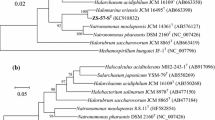Abstract.
Two strains (5Z and 20Z) of halotolerant alkaliphilic obligate methanotrophic bacteria were first isolated from moderately saline soda lakes in Tuva (Central Asia). The strains grow fastest at pH 9.0–9.5 and much more slowly at pH 7.0. No growth occurred at pH ≤ 6.8. They require NaHCO3 or NaCl for growth in alkaline medium. Gram-negative, motile rods with ordered cup-shaped cell wall structures and Type I intracytoplasmic membranes assimilate methane and methanol via the ribulose monophosphate pathway. The G + C content of strains 5Z and 20Z are 47.6 and 47.9 mol%, respectively. Based on their alkaliphilic physiology, both strains were referred to as Methylobacter alcaliphilus sp. nov. The changes in cell phospholipids, fatty acids, and amino acids have been observed upon varying salinity and pH of the medium, thus suggesting structure-function osmoadaptation of the strains studied. Whole-cell experiments revealed the salt- and pH-dependence of CH4 oxidation and assimilation rates. Cell motility was also Na+ dependent and sensitive to some energy uncouplers and ionophores.
Similar content being viewed by others
Author information
Authors and Affiliations
Additional information
Received: 7 March 1997 / Accepted: 14 April 1997
Rights and permissions
About this article
Cite this article
Khmelenina, V., Kalyuzhnaya, M., Starostina, N. et al. Isolation and Characterization of Halotolerant Alkaliphilic Methanotrophic Bacteria from Tuva Soda Lakes. Curr Microbiol 35, 257–261 (1997). https://doi.org/10.1007/s002849900249
Issue Date:
DOI: https://doi.org/10.1007/s002849900249




